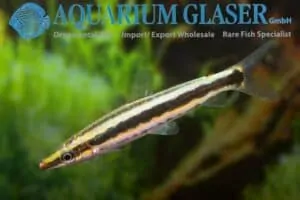Corydoras adolfoi
Corydoras adolfoi was officially described by Burgess in 1982. The genus name Corydoras consists of two parts: Cory means “helmet” and doras means “skin”. The name is a reference to the double row of bony plates under the skin on the flank of this genus. These bony plates act as a kind of armor, hence the common collective name for this group of fish: Armored Catfish. Due to the possession of the bony plates, they do not need any further protection, so they do not have scales.
The species name adolfoi is in honor of the fish catcher and exporter Adolfo Schwartz of Tyrkys Aquarium in Manaus Brazil. He has been of great value to TFH Publications in capturing and securing rare, unknown and interesting species.
Description
Corydoras adolfoi is a schooling fish that is best kept with a minimum of 6 to 8 pieces. Very very peaceful species, which can be kept together very well with South American Tetras. With a school of Tetra’s in the middle, this fish will be stimulated to show itself a lot.
The difference in gender can be seen in the shape and size. The female is thicker and larger than the male.
Origin
Brazil, Rio Negro, near Saão Gabriel da Cachoeira, Roi Uaupes.
Diet
Corydoras adolfoi is omnivorous but they prefer small live food. Dry food in the form of tablets is also popular.
The Aquarium
The aquarium must have a minimum length of 60 centimeters. But I prefer 80 centimeters. Furthermore, a dark sandy bottom. The substrate should not be sharp (this applies to all bottom dwellers) as they can damage their barbels. The aquarium should be densely planted. With a little bit of free soil to dig on. Soft and black water is their main preference.
On the bottom, you prefer to use rounded (filter) sand. They dig through the substrate with their barbels. Using sharp sand or gravel can damage their barbels. The damage causes inflammation where they sometimes even lose their complete barbels. It is, therefore, better to keep them on non-sharp sand. By the way, the barbels grow back slowly as soon as they are kept on sand again.
In nature, fish have to deal with fluctuating temperatures. Keeping fish at the minimum or maximum temperature for a long time is not always desirable and can shorten the average lifespan of the fish.
Breeding Corydoras adolfoi
Several Corydoras adolfoi have to be used for breeding. Each female lays about 25 to 30 eggs in 2 weeks, which are glued to the glass of bread leaf. The fry can be raised with infusoria, microworms and newly hatched brine shrimp. The parents must be removed after spawning, otherwise, they will eat the eggs. If you don’t want to remove the parents, you can always try to remove the eggs (without removing them from the water, although this usually damages them).
Comments
Beware! Corydoras adolfoi is sometimes confused with Corydoras duplicareus (which remains much smaller but looks exactly the same, except for the often thicker black stripe on the back. This is also cheaper on the market, but not as commonly available as adolfoi) and with De Corydoras imitator (this one has a longer snout than the adolfoi.
Transporting Corydoras
Many Corydoras species have a venomous self-defense mechanism to avoid being eaten by larger fish. In case of danger, they can spread and lock the spines in their dorsal and pectoral fins. As a result, they get stuck in the mouth or throat of the attacker, so that another fish will not want to swallow a Corydoras.
Even when catching a Corydoras with a net, they regularly hang in the net with these spines. Be careful when loosening, if the spine gets into your skin it can partially break off and remain in the skin. These wounds are painful and often become inflamed.
In addition to the pointy spines, some Corydoras species can release a toxin into the water when stressed or in danger. When transported in too small a volume of water or too many Corydoras in the small space, this can lead to rapid death among the fish. It is therefore preferable to only transport the Corydoras with other Corydoras and not too much in one bag.
Because little research has been done on this venom, it is not clear whether this venom is spread from the gills or from the spines. It is thought that at least Corydoras adolfoi, Corydoras arcuatus, Corydoras melini, Corydoras metae, Corydoras panda, Corydoras robineae, Corydoras rabauti, Corydoras atropersonatus, Corydoras sterbai and Corydoras trilineatus have this poison.
Video
Authors
CB
John de Lange
Copyright images
Tekkelke
Resources
Aquavisie
Amazoona.be (niet meer beschikbaar)
Wikipedia
Clownbotia.webs.com (niet meer beschikbaar)








Reviews
There are no reviews yet.